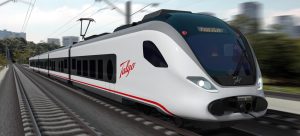 Talgo has presented its hydrogen train propulsion system, which is the first such prototype in Spain. The first track validation tests will take place in the fourth quarter of 2021 on the Extremadura railway network, in western Spain, at the border with Portugal.
Talgo has presented its hydrogen train propulsion system, which is the first such prototype in Spain. The first track validation tests will take place in the fourth quarter of 2021 on the Extremadura railway network, in western Spain, at the border with Portugal.
This hydrogen system is configured as a modular solution that can be installed on all types of trains, but has been specifically designed for the urban and medium distance Vittal platform, with which Talgo competes in various bidding processes in Spain and other countries.
This innovative system uses hydrogen batteries that provide the energy for the train’s electric motors. It is powered by renewable energy sources, such as solar photovoltaic or wind, which produce hydrogen that is stored and then used to power fuel cell-based propulsion systems, such as the one designed by Talgo. The system is complemented by batteries that increase the speed of the train when it starts, taking advantage of the braking system to recharge it.
Unlike the extended battery systems in the automotive industry, the hydrogen technology is the logical answer to the needs of heavy transport and, in particular, of those railway lines that do not have catenary electrification systems, and which today depend on trains powered by diesel engines.
The hydrogen train propulsion system designed by Talgo offers an efficient alternative to replace the diesel engines running on the non-electrified conventional railway network.
The manufacturer selected Extremadura railway lines as part of a broader strategy that recognizes the efforts of Extremadura’s civil society, business and regional public administrations to innovate and accelerate a transition to completely decarbonized transport system. Extremadura it is one of the Spanish regions that have expressed a more decisive commitment to the creation and regeneration of industrial networks based on the local production of hydrogen.
The system has been presented in Don Benido, Badajoz, within the framework of the SOI H2 Conference, on the possibilities that hydrogen technologies present in the Southwest of the Iberian Peninsula (SoI).
Share on:



